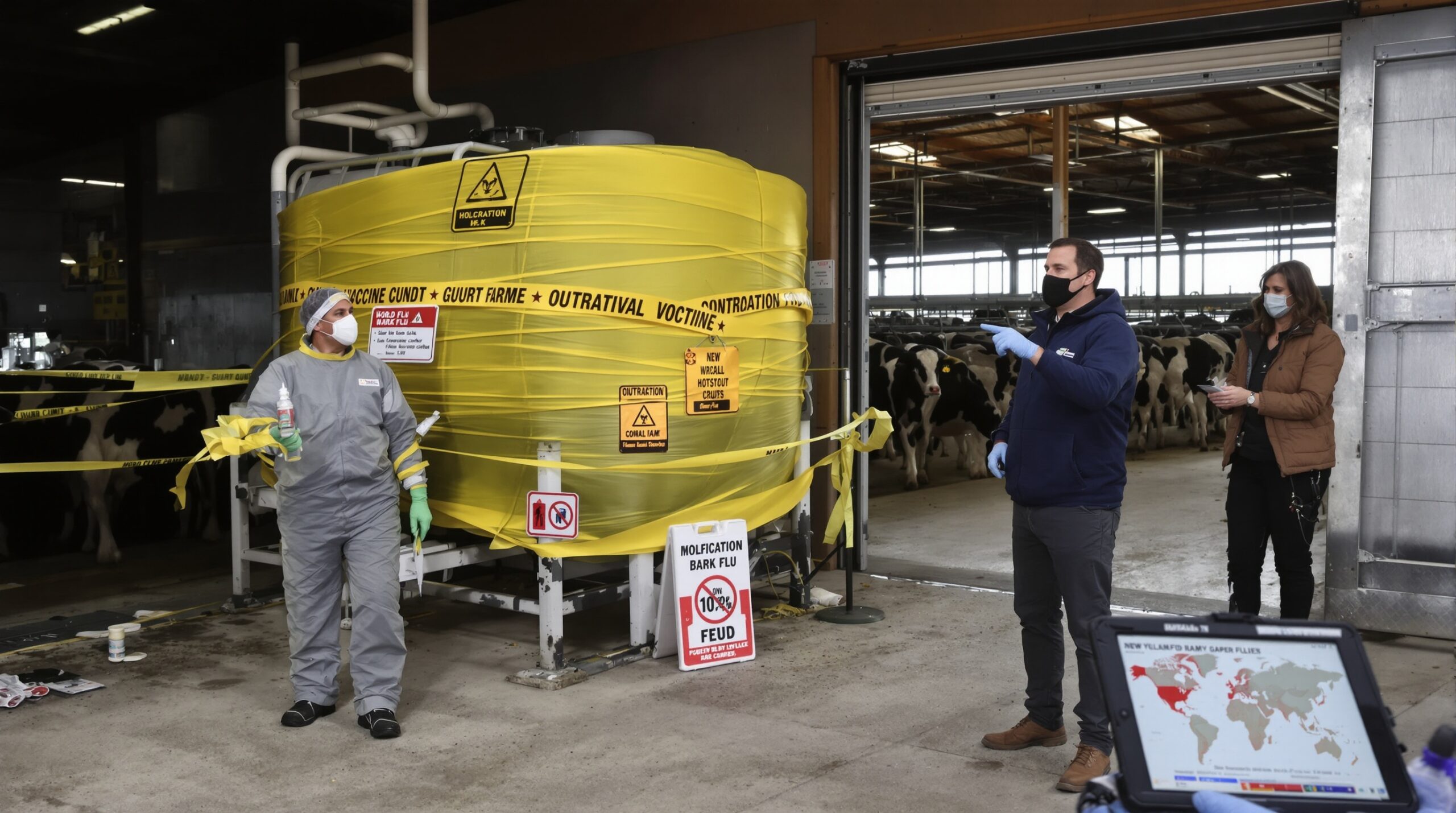Global surveillance has tracked avian influenza for decades across birds and mammals. Recently, outbreaks reached commercial dairy herds. It also accelerates conversations about food safety, worker protections, and vaccination strategies. Health agencies are adapting guidance as evidence evolves.
The United States has reported H5N1 detections in dairy cattle since early 2024. Investigations suggest spillover from infected wild birds and contaminated environments. Farm management practices can amplify the spread once introductions occur. Coordinated control measures aim to reduce within-herd and between-herd transmission.
How avian influenza reached dairy herds
Wild waterfowl carry highly pathogenic avian influenza across migratory routes. Dairy operations interacting with shared landscapes face greater exposure risks. Biosecurity gaps let viruses cross fences and reach vulnerable animals. Strengthening barriers helps interrupt these environmental transmission chains.
Human activity also introduces risk. Equipment can carry virus particles between farms. Contract workers often visit multiple facilities during peak seasons. Partnerships with wildlife agencies add support around deterrence and habitat management.
What scientists know about the virus in cattle
Diagnostic testing has confirmed H5N1 in nasal swabs, milk, and feces from affected cows. Many cows show reduced appetite, fever, and decreased milk yield. Early data indicate limited mortality in adult cattle so far. However, productivity losses and animal welfare concerns remain significant.
Researchers have detected high viral loads in raw milk from sick cows. Laboratory studies suggest pasteurization inactivates the virus effectively. A viable virus has not been found in properly pasteurized milk. This evidence supports continued confidence in regulated dairy products.
Food safety and pasteurization safeguards
Public health agencies advise consumers to choose pasteurized milk and dairy. They warn against drinking raw milk during outbreaks. Pasteurization standards, including High Temperature Short Time, neutralize many pathogens. These standards also protect against bacterial contaminants like Salmonella and Listeria. Clear labeling helps consumers make safer choices quickly.
Authorities are increasing inspections at processing plants. They are also sampling milk from bulk tanks and retail shelves. Consistent communication supports market stability and consumer trust. Strong coordination across agriculture and health departments improves response speed.
Farm biosecurity and worker protections
Containment on farms relies on layered biosecurity. Managers restrict visitors and monitor animal movements closely. Disinfection stations handle boots, tires, and equipment. Feed and bedding deliveries follow controlled routes with documentation. These steps reduce opportunities for virus entry and exit.
Workers face occupational risks through close contact with sick animals. Health authorities recommend eye protection, gloves, and well-fitted respirators. Paid sick leave policies encourage early reporting of symptoms. Transitioning practices also include vaccination against seasonal influenza for workers.
Occupational health programs are expanding testing access for farmworkers. Clinicians monitor patients for conjunctivitis and respiratory symptoms. Case investigations help trace exposures and identify high-risk tasks. Lessons inform improved engineering controls and workflow adjustments.
Animal health interventions and trade impacts
Veterinarians implement quarantines, testing, and movement permits in affected regions. Herds with active infection pause sales and transfers. These steps limit spread while laboratories sequence viral genomes. Sequencing reveals introductions, clusters, and possible adaptation markers. Findings guide targeted interventions and policy decisions.
International trade partners monitor developments closely. Some countries adjust import requirements for dairy cattle and products. Clear certification and transparent reporting reduce unnecessary disruptions. Transitioning policies balance economic stability with biosecurity goals.
Culling decisions differ from poultry responses. Most dairy herds manage cases without mass depopulation. Support focuses on isolation, veterinary care, and milk disposal. Compensation mechanisms vary by jurisdiction and sector. Policy reviews consider sustainable approaches that protect livelihoods and health.
The vaccine debate for humans and animals
The spread to cattle revives debates about vaccination strategies. Public health planners assess whether to preposition H5N1 vaccines for workers. Poultry vaccination remains a separate, ongoing policy discussion. Dairy cattle vaccination would require safety data and regulatory approvals. These considerations demand transparent goals and clear risk thresholds.
Existing candidate vaccine viruses match circulating clades moderately well. Manufacturers can produce adjuvanted doses for targeted groups. mRNA platforms offer flexibility if antigenic drift accelerates. Stockpiles and fill-finish capacity influence deployment speed. Coordination ensures doses reach priority populations without waste.
Manufacturing capacity and deployment logistics
Scaling vaccines requires raw materials, bioreactors, and trained staff. Supply chains must deliver vials, stoppers, and specialized filters. Cold-chain storage and distribution further constrain timelines. Healthcare networks plan clinics and consent processes for workers. Clear eligibility criteria avoid confusion during early rollout.
Communication remains essential throughout planning and deployment. Transparent messages explain benefits, risks, and uncertainties. Community leaders and producer groups can amplify trusted information. Feedback channels identify concerns and misinformation quickly. Adaptive strategies improve uptake while respecting local contexts.
Surveillance, data sharing, and mutation monitoring
Scientists are sequencing viruses from cattle, birds, and humans. They compare genomes to track introductions and possible mammalian adaptation. Particular attention focuses on receptor binding changes and polymerase mutations. These markers could influence transmission or clinical severity. Regular analysis informs risk assessments and preparedness planning.
Serosurveys measure exposure among farmworkers and veterinarians. Wastewater monitoring can supplement farm and clinical testing. Environmental sampling identifies contamination hotspots around facilities. Data integration platforms speed alerts to decision makers. Cross-border collaborations strengthen shared situational awareness.
Ethical, legal, and communication challenges
Policies must balance public health with individual rights. Worker protections should not penalize reporting or testing. Confidentiality safeguards encourage participation in surveillance programs. Community engagement reduces stigma and supports compliance. These principles protect both workers and broader society.
Legal frameworks govern reporting obligations, animal movements, and compensation. Clear statutes aid rapid decisions during outbreaks. Interagency agreements clarify roles before emergencies arise. Exercises test protocols and highlight gaps. Improvements follow with training and resource investments.
What consumers should know now
Risk to the general public remains low at this time. People should avoid raw milk and unpasteurized dairy products. Consumers should cook eggs and poultry to safe temperatures. Workers with exposure should follow employer and health guidance closely. Stay informed through credible sources and local advisories.
Grocery shelves continue to offer safe, pasteurized options. Regulatory oversight and industry controls remain strong. Prices may fluctuate if outbreaks affect supply chains. Community patience supports careful, science-driven responses.
The road ahead
The dairy events reinforce the One Health approach. Human, animal, and environmental health are interdependent. Integrated surveillance and cross-sector planning remain essential. Investments in biosecurity, vaccines, and communication will pay dividends. Continued research will clarify transmission dynamics and intervention effectiveness.
Preparedness requires flexible tools and transparent decision making. Cooperation across borders and disciplines strengthens resilience. As conditions evolve, guidance will adjust with new evidence. Communities that learn and adapt will navigate uncertainties better. The goal remains health protection without unnecessary disruption.


